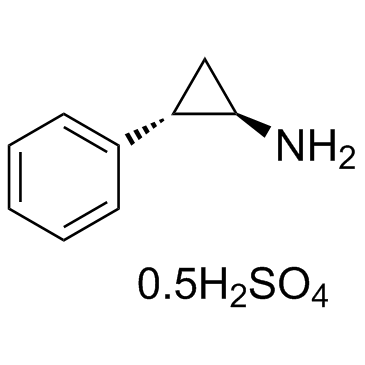Tranylcypromine hemisulfate (dl-Tranylcypromine hemisulfate) |
| Catalog No.GC30766 |
Tranylcypromine(SKF 385) hemisulfate는 우울증 치료에 사용되는 비가역적 비선택적 모노아민 산화효소(MAO) 억제제입니다.
Products are for research use only. Not for human use. We do not sell to patients.

Cas No.: 13492-01-8
Sample solution is provided at 25 µL, 10mM.
Tranylcypromine hemisulfate is an irreversible, nonselective MAO inhibitor used in the treatment of depression.
Tranylcypromine (10 nM to 10 µM) exerts neuroprotective effects against toxicity induced by human Aβ(1-42) oligomers independently from the presence of glial cells[1]. Tranylcypromine (100 μM) significantly protects RGCs from glutamate neurotoxicity-induced apoptosis as well as apoptosis induced by oxidative stress. Tranylcypromine promotes mitogen-activated protein kinase 12 (p38 MAPKγ) expression under conditions of glutamate (Glu)-induced stress. Besides, tranylcypromine contributes to RGC survival via alterations of p38 MAPKγ activity[3].
Tranylcypromine treatment significantly and substantially reduces the lesion size and improves generalized hyperalgesia in a dose-dependent fashion in mice with induced endometriosis. In addition, tranylcypromine treatment results in reduced immunoreactivity to biomarkers of proliferation, angiogenesis, and H3K4 methylation, leading to arrested EMT and lesion growth[2]. Tranylcypromine (500 mM) injection exerts neuroprotective effects within intracellular apoptotic signaling pathways and suppresses morphologic changes in the retina of the rat, suppresses caspase 3 activity and recovers p38 MAPKγ expression in the retina after NMDA-induced injury, and enhances RGC survival after retinal injury via the attenuation of NMDA neurotoxicity[3]. Tranylcypromine (10 µg/g) causes an approximate and significant doubling of labeled cells in the combined brain regions examined, as detected by BrdU immunohistochemistry. Tranylcypromine causes the greatest increase in cell proliferation in the cerebellum[4].
[1]. Caraci F, et al. Neuroprotective effects of the monoamine oxidase inhibitor tranylcypromine and its amide derivatives against Aβ(1-42)-induced toxicity. Eur J Pharmacol. 2015 Oct 5;764:256-263. [2]. Sun Q, et al. Tranylcypromine, a lysine-specific demethylase 1 (LSD1) inhibitor, suppresses lesion growth and improves generalized hyperalgesia in mouse with induced endometriosis. Reprod Biol Endocrinol. 2016 Apr 9;14:17. [3]. Tsutsumi T, et al. Potential Neuroprotective Effects of an LSD1 Inhibitor in Retinal Ganglion Cells via p38 MAPK Activity. Invest Ophthalmol Vis Sci. 2016 Nov 1;57(14):6461-6473. [4]. Romanczyk TB, et al. The antidepressant tranylcypromine alters cellular proliferation and migration in the adult goldfish brain. Anat Rec (Hoboken). 2014 Oct;297(10):1919-26.
Average Rating: 5 (Based on Reviews and 35 reference(s) in Google Scholar.)
GLPBIO products are for RESEARCH USE ONLY. Please make sure your review or question is research based.
Required fields are marked with *




















